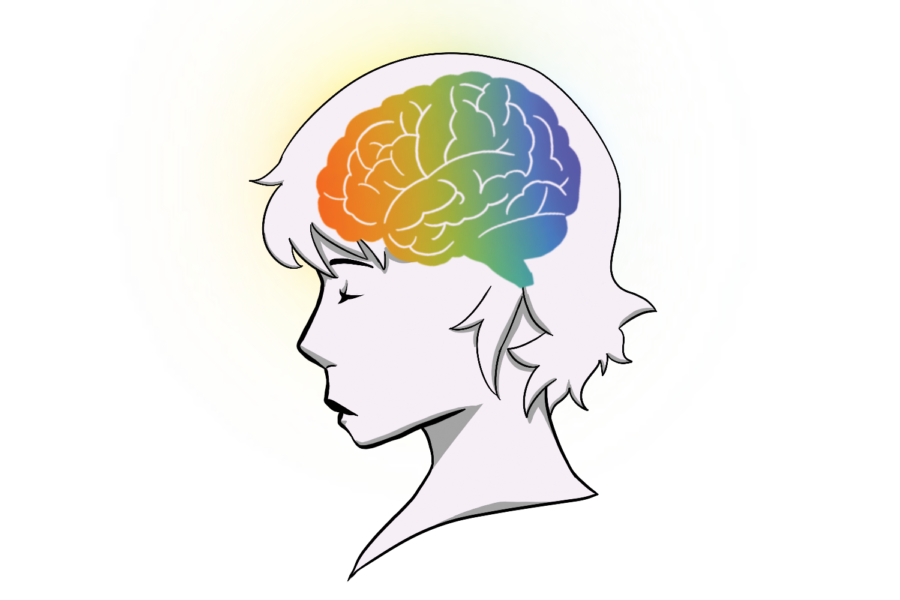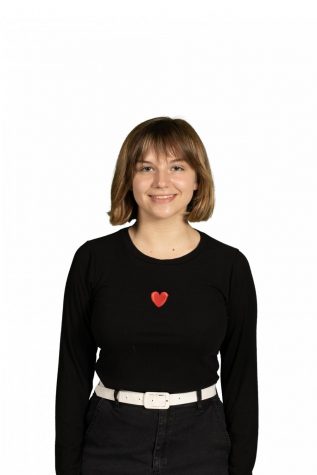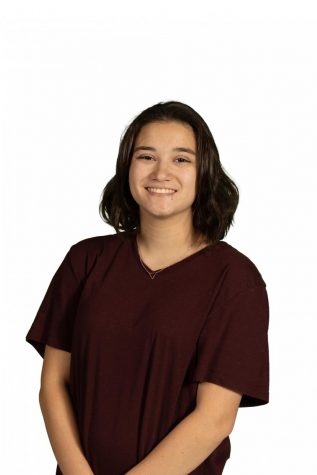Gender genes
Signs of mental disorders present differently in women
Photo by Allyson Smith
A multicolored brain rests in a neurodivergent woman’s head. The amount of women with disorders such as ADHD and autism may be vastly underreported.
May 2, 2022
She perched on her desk observing her peers giggling, conversing, connecting. Yet most of them had no interest in engaging with her. Her mind wanted to form bonds with others, but her mouth couldn’t say the right words to form the lasting connections she longed for. Her friendship circle was the size of her eyes that watched the world treat her like an outsider. All because of traits that she couldn’t control.
To her peers during elementary school, junior Emma Thornton was an oddity. She was unhelpful in group projects as few things maintained her attention. Her thoughts bounced from topic to topic at a pace others couldn’t keep up with.
For these reasons and more, she became an easy target of ridicule for the others in her class. Neither her classmates, family or herself knew exactly what set her apart, but she can now put a name to her state of being: neurodivergence.
Thornton specifically has ADHD (Attention Deficit Hyperactivity Disorder), but according to ADHD Aware 30 to 40% of the population is classified as some form of neurodivergent, a term encompassing any disorders involving atypical brain functions. Several disorders, such as ADHD and autism, have a higher percentage of diagnosed men versus women. This may partially be a result of how some neurodivergences present differently in women.
“I think women are better at hiding things than men are,” Special Populations Principal Debbie Davis said. “I feel it’s very important for people to know what the signs are. A lot of times, especially in older kids, it takes [the child] to be able to say, ‘These things describe who I am.’”
ADHD is characterized by traits such as excessive energy and disorganization. Signs can appear in and out of school, ranging from problems with emotional regulation to disruptiveness during class. Thornton’s condition is an obstacle socially and academically.
“[ADHD] affects pretty much everything about my life,” Thornton said. “You can see it reflected in my social life, my behavior, and my ability to get things done but also how I interact with people as well as how I see myself. Sometimes I react impulsively or say things without a filter.”
The National Library of Medicine reports that there are four men diagnosed with ADHD for each woman with the same label. Many women’s symptoms are more subtle than men’s, with females being more adept at controlling the indications of the disorder.
“Girls tend to hold it in and let their energy out in the hallways,” Davis said. “In the classroom, they’re gonna be your pen clickers. They’re gonna be your doodlers. They just have to constantly be moving, and they struggle to pay attention.”
Men, however, typically fall into more stereotypical ADHD behaviors. A possible explanation for the gender-based discrepancy is that many symptoms of ADHD are merely traits commonly found in young boys.
“We see those typical things when we think of autism or the typical things when we think of ADHD, and, first off, it just describes a boy,” Davis said. “Lots of energy, likes to talk, disorganized. Hello, that’s your average teenage boy.”
Some traits of ADHD are often internal and thus more difficult to recognize, such as emotional responses to one’s environment.
“It’s less of ‘I have mood swings just because.’ I feel like I need less stimulation or situations to change,” Thornton said. “My mood is more easily swayed by smaller things, and I’m more likely to respond to less stimulation.”
A common trait in both people with ADHD and autism is adopting unusual or intense pastimes called special interests. The length of time one devotes to their special interests varies depending on the person, but some of autistic senior Emma Tucker’s have remained a part of her throughout adolescence.
“Some people, their special interest is trains and they love trains,” Tucker said. “Mine would be movies and T.V. I think the longest lasting ones for me are the ‘Captain America’ movies and ‘Supernatural.’ It’s been my thing seven years at this point.”
Common indicators of autism include repetitive behaviors, atypical sensory processes and struggles with verbal or nonverbal communication. No two people experience the disorder in the same way. Some are nonverbal and require enrollment in special needs programs, whereas others learn alongside their neurotypical peers but may struggle socially or become easily over or understimulated.
“Autism is such a wide spectrum that you can’t say, ‘This is your typical person with autism,’” Davis said. “Just because you’re on that spectrum doesn’t mean you’re going to have every single one of the things we look for. I can think of at least four kids on this campus with autism, and every one of them makes me smile because every one of them thinks so differently.”
Tucker’s autism affects her social relationships as well as her general response to the world. While ADHD may be easier described with a list of typical behaviors, autism is more difficult to put into words due to the variety of ways people experience it.
“It’s hard to explain how it affects me because I’ve always been like this,” Tucker said. “I wouldn’t know how a neurotypical person would feel. It affects just how I process the world and how I react to things. It’s just an overall thing.”
Like ADHD, autism is estimated by the National Library of Medicine to have a 4:1 ratio of diagnosed men vs. women. All people, but women especially, are often initially misdiagnosed with ADHD and later diagnosed with autism. This does not mean autistic women have any fewer traits of the disorder than their male counterparts.
“A lot of times when you find a female with autism, it is a little bit more severe,” Davis said. “At least that is what I have seen in my years of experience with this. When you’re looking for autism, people think of people who can’t make eye contact, people who are socially awkward. The girls that I have tended to see [are] very sensory oriented, very much routine driven. The sensory is probably the biggest thing that I see with them.”
Tucker is one of many autistic women who struggle to adapt to the stimuli of different environments. She was tested for the disorder following her younger brother’s diagnosis.
“I’m sensitive to certain things like lights and sounds and textures,” Tucker said. “Texture is a big thing. Some things that can be really awful for me at one point can be completely fine at another point in time. If I’m overwhelmed, or overstimulated I have to retreat.”
There are currently more men than women reported to have ADHD or autism at Texas High School, but people can receive a diagnosis at any point in their lives.
“Typically, I’ve seen that as students get older. Their symptoms never go away,” Davis said. “But they diminish because they learn how to control things. Girls tend to do that faster than boys.”
Regardless of a specific diagnosis, neurodivergent people perceive the world through a slightly different lens than the typical mind. Although neurodivergence can divide people in ways such as feeling out of place in childhood and beyond, those like Tucker and Thornton desire the same human decency any typical brain can receive.
“Everyone’s different,” Tucker said. “A lot more people are on the spectrum than most people realize. A lot of people don’t even realize they’re on it themselves. Everyone should treat everyone like they’re humans and not be awful to specifically neurodivergent people because a lot of people don’t understand anything about it.”
















